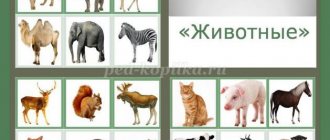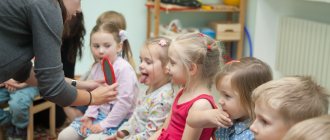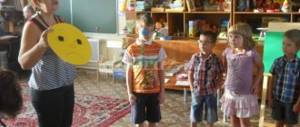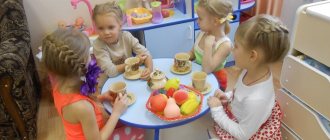Plot-didactic game: features and tasks. presentation for a lesson on the topic
Slide 1
Plot-didactic game: about features and tasks.
Slide 2
- is a multifaceted, complex pedagogical phenomenon: it is also a game method of teaching preschool children, a form of education with independent play activities, and a means of comprehensive education of the child’s personality. Didactic game-
Slide 3
It represents a detailed plot. It includes a variety of roles and rules. Plot-based didactic games are a multifaceted phenomenon, in the process of which not only the acquisition of educational knowledge, skills and abilities occurs, but also all the mental processes of children, their emotional and volitional sphere, abilities and skills develop. Plot-didactic game-
Slide 4
The peculiarity of plot-based didactic games is that, taking the role of an adult, the child acts according to the rules dictated by this role: he reproduces the actions of adults, taking into account the number with which it is necessary to operate, the duration and time of the actions performed, etc.
Slide 5
— mastering new knowledge; — formation of mental skills; — use of acquired knowledge in various situations; — development of children’s speech activity. In such games the following tasks are solved:
Slide 6
- the teacher has certain knowledge and skills regarding plot-based didactic games; - expressiveness of the game. This ensures children's interest, desire to listen and participate in the game; — the need to include the teacher in the game. He is both a participant and leader of the game. The teacher ensures the progressive development of the game in accordance with educational and educational tasks, but at the same time does not exert pressure, plays a secondary role, and, unnoticed by the children, directs the game in the right direction; Basic conditions for conducting plot-didactic games:
Slide 7
— the need to establish mutual understanding, trust and respect between the teacher and children; — the visualization used in the didactic game should be simple and succinct.
Slide 8
formulation of goals and objectives of games; introduction of the plot; selection of teaching materials; creating a problematic situation; taking into account the time factor; summarizing . Organization of plot-didactic games:
Slide 9
with analogue toys; with literary characters; and games - travel. Main types of plot-didactic games:
Slide 10
In this case, educational and gaming goals complement each other.
Card index of didactic games
Modern preschool educational institutions operate in strict accordance with the Federal State Educational Standard for Preschool Education (FSES DO). The Standard states that preschool institutions must ensure the social, communicative, cognitive, speech, artistic, aesthetic and physical development of children (clause 2.6.). Therefore, when developing a calendar-thematic plan for educational activities, the educator must take into account the classes implemented in the form of DI. The thematic plan should include games that, in terms of their educational objectives, meet the requirements of the standard.
Table: card index of didactic games in junior groups
| Direction of child development | Name | Tasks | Description |
| Speech | "Wonderful chest" |
| The teacher takes out various objects from the chest (box), the children name the object or get acquainted with a new object. |
| "Lotto" |
| The teacher has illustrations of objects in the singular, and the children have similar pictures, where there are several objects. The child whose picture matches the one shown by the teacher says what is shown on it. | |
| Cognitive | "Matryoshka" | Form ideas about surrounding objects (shape, part and whole). | The teacher invites the children to perform various actions with the toy: examine, assemble, disassemble. |
| "Pyramid" | Form ideas about surrounding objects (shape, color, size, part and whole). | The teacher lays out several disassembled pyramids with multi-colored rings and mixes them. Gives each child a ring of the same size and color and instructs them to find an identical pair for their ring. | |
| Physical | “Let’s recognize the color and act!” |
| The teacher keeps and distributes objects of different colors to the children. Shows objects of one or another color. If the color of the object matches between the child and the teacher, the child performs an action (runs, jumps, etc.), if it does not match, then the activity does not occur. |
| “Empty Place” (version of the folk game) | Form strong-willed qualities and control over your behavior. | Participants run around the circle from different sides. The winner takes a seat, for example, a chair, the loser takes the lead. The driver chooses his partner. | |
| Social-communicative | “What did Parsley choose?” | To develop organization and mutual assistance in children. | The teacher alternately demonstrates the sounds of different instruments, then continues these actions, but behind a screen, the children guess which object makes the sound. |
| "Silent women" | Develop readiness for self-control. | After the command “silence” there is silence. If the child laughs, speaks or moves, he gives the presenter a forfeit. Forfeits are “buyed back” at the end of the game. | |
| Artistic and aesthetic | "Sea" |
| The music worker (teacher) performs a musical piece, the children talk about the feelings and emotions that arise in them, and share their impressions. |
| "Assemble a pattern" |
| Children collect pictures from fragments depicting folk crafts. |
Table: card index of didactic games in the middle group
| Direction of child development | Name | Tasks | Description |
| Speech | "Hot Cold" | Add antonyms to your active dictionary. | The teacher pronounces an adjective, and the child responds with an adjective with the opposite meaning. You can use a ball or other objects. |
| "The Beast and His Cub" |
| The ball is thrown from the teacher to the child, the throw is accompanied by the name of an adult animal, the child in response names the baby of this animal. | |
| Cognitive | "Guess the time of year!" | To form an idea of the planet Earth, its nature, the properties of objects in the surrounding world. | The teacher reads a text, a poem, a riddle about the seasons and asks the children what time of year they are talking about. |
| "Good bad" |
| The teacher voices a problematic topic (for example, snowfall). Children give their assessment of the phenomenon. | |
| Physical | "Gathering the Harvest" | Form motor activity, coordination, motor skills. | The teacher tells the children that they are gardeners, and the balls are fruits that need to be collected in baskets. Children take turns throwing “fruits” into the basket: “apples” with their left hand, and “pears” with their right hand. |
| "The Fisherman and the Fishes" | To form experience in motor activity aimed at developing coordination. | Fishermen try to capture as many fish children as possible with a net (rope). | |
| Social-communicative | "Let's say hello!" |
| The teacher and children talk about different ways of greeting both among people and among animals, come up with their own, and demonstrate them. |
| "Tell about yourself" |
| The child is asked to say his name, briefly talk about his hobbies, habits, etc. | |
| Artistic and aesthetic | "Finish the picture" | Develop fantasy and imagination through visual activities. | Objects are partially drawn in the pictures; you need to finish drawing and coloring the missing parts. |
| “Paint the handkerchief” |
| While playing, the child makes simple patterns from various decorative elements. |
Table: card index of didactic games for older preschoolers
| Direction of child development | Name | Tasks | Description |
| Speech | "Broken Phone" | Develop auditory attention and speech skills. | The teacher whispers a word to the child sitting next to him, who passes it to the child sitting next to him, etc. The last player names the word that he heard. Afterwards, the distortion of the original word is checked and the link where this occurred is determined. |
| "Third/fourth wheel" | Strengthen the ability to perceive information by ear and speech skills. | The teacher names the objects of the set and, among others, names an object that is not related to the given set; who notices an error, declares this, for example, by clapping his hands. | |
| Cognitive | “What do they plant in the garden?” | To develop the ability to classify objects in the surrounding world according to the designated criteria. | The teacher asks the children to answer in the affirmative if the object of the surrounding world he named is a garden plant, and vice versa. |
| "Houseplants" | To form ideas about planet Earth and its nature. | Children take turns passing a ball or other object and say the names of indoor plants. | |
| Physical | "Catch the mouse!" | Develop dexterity, attentiveness, coordination. | Players are divided into 2 groups: mousetraps and mice. The mousetraps line up in a circle, join hands and, at the command of the leader, raise their hands. Mice run through mousetraps. At the word “clap,” the children in the circle lower their hands. Some of the mice are caught and they stand in a circle. The game ends when all the mice are caught. |
| “Hugging salutes!” | Develop dexterity, attentiveness, coordination. | The driver catches the players running away from him, the one caught and the driver hug and change roles. | |
| Social-communicative | "Web of Friendship" | Develop a readiness for open communication, attention, and friendliness. | The child winds the thread around his finger, after which he says some information about himself and throws the ball to another participant in the game. In which all participants are connected. |
| "Postman" | Develop a willingness to work in a team. | The driver-postman says: “I am sending a postcard from Katya to Masha.” Katya passes the “postcard” by shaking hands with her neighbor, etc., until the “postcard” reaches the addressee. Everyone should be a postman. | |
| Artistic and aesthetic | "What it is?" | Develop the ability for associative thinking. | The teacher shows a certain object and suggests finding similarities with something else. |
| "Cloud" | Develop imagination and imaginative perception of the world around you. | Children look at the sky, clouds, clouds. The teacher invites you to fantasize and tell them what the clouds look like and where they float. |
Note that the names of games, tasks and descriptions given in the card indexes can be specified and supplemented depending on the game situations, individual characteristics of the participants, as well as the desire of the teacher to mobilize their professional and personal potential when conducting classes in a game form. Game attributes can be very diverse, right down to improvised materials. The teacher can use game material in ready-made form, or can make it himself, including with the help of children, but for verbal games no material is required at all.
The importance of story-based didactic games in the formation of mathematical concepts in preschoolers
Author:
Karpovich Svetlana Yurievna,
teacher of MADOOU d/s No. 158 of the city of Tyumen.
Pedagogical work experience - 20 years.
First qualification category.
Relevance of the topic
For the full development of a child’s personality, the process of acquiring mathematical knowledge that forms mental processes is important.
Mathematics begins with elementary arithmetic operations.
But preschoolers do not always understand why accurate, not approximate, counting is needed. Without understanding the meaning of the actions being performed, they carry out the assigned tasks without thinking.
It has been proven that the basis for the formation of a child’s understanding is object-sensory activity, through which it is easier to master mathematical skills.
The main type of object-sensory activity of a child is play.
Experience shows that a harmonious combination of learning and play enables children to better understand the world. This contributes to the education of full-fledged individuals.
The main objective:
Formation of mathematical knowledge about the world around us in preschoolers through plot-based didactic games.
Main goals:
Expand and deepen the arithmetic knowledge and skills of children in the middle group.
Encourage children's cognitive interest and promote the development of mental processes.
The importance of story-based didactic games in the formation of mathematical concepts in preschoolers
Life through the eyes of a child is a game, an experiment, so it is better to use arithmetic knowledge in a playful way. It is often useful and exciting to play out situations and events that adults encounter. Children willingly take part in such plot-based didactic games as “On the ship”, “In the clinic”, “Shop”, “Hairdresser”.
During the games “Circus” and “Zoo” the children develop spatial concepts. The teacher asks the children questions about the location of the animals in the arena: “Who is on the right? Left? To the right of...? In the center? Higher? Below? Higher than…?". And so on.
Through similar questions asked during the game “Breakfast, Lunch, Dinner,” the teacher helps develop the child’s understanding of the location of objects in space relative to each other. With the help of visual materials, children perform basic mathematical tasks.
Plot-didactic games consist of three stages:
1. At first, the game has a plot-didactic character. The leading role belongs to the teacher, who monitors the children’s arithmetic operations and, if necessary, helps direct the process in the right (game) direction.
2. The plot-didactic game flows into the plot-role-playing game (these could be the games “Math in DS”, “Mail”, “In a cafe”, “Bus”). Children begin to play leading roles.
3. Independent role-playing activities emerge on the initiative of children, who themselves come up with new games with great interest, using their acquired counting skills. At this stage, the teacher only monitors the progress of the game activity.
Interaction with parents
The interaction between parents and child is based on kindness and individuality. These qualities help children develop their positive skills, abilities, achievements and contribute to the development of the child as a person, an individual.
Implementation of the principles on which communication with parents is based helps to quickly build a “bridge of relationship” with each of them.
Parents rejoice with us at their children’s successes and help them.
Interaction with teachers of MADOU
Didactic games can be carried out in parallel in different areas of children’s cognitive activity: for example, learning to count can be interspersed with classes in the art studio and music room.
Such interaction with MADOU teachers immerses the child in a holistic world of knowledge through various types of art.
Results
The importance of plot-based didactic games in the formation of mathematical concepts in preschoolers is very great.
In the game, children can prove that they are right, openly express their opinions - this is how a personality is formed.
Globally, the teacher’s task is to prepare the child not for school, but for life; give children freedom and not limit their potential.
Bibliography
- Bondarenko A.K. Didactic games in kindergarten: a book for kindergarten teachers. - M.: Education, 1982.
- Karpova E.V. Didactic games in the initial period of education. A popular guide for parents and teachers. - Yaroslavl: Academy of Development, 1997.
- Serbina E.V. Mathematics for kids. —.M.; Enlightenment, 1992
- Smolentseva A.A. Plot-didactic games with mathematical content.—M.: Education, 1987. -96 p.
Program:
N. E. Veraksy, T. S. Komarova, M. A. Vasilyeva. The main general educational program of preschool education “From birth to school.”— M.: Mozaika-Sintez, 2012. -391 p.
Photos are from the archive of teacher S. Yu. Karpovich.
We invite teachers of preschool education in the Tyumen region, Yamal-Nenets Autonomous Okrug and Khanty-Mansi Autonomous Okrug-Yugra to publish their teaching materials: - Pedagogical experience, original programs, teaching aids, presentations for classes, electronic games; — Personally developed notes and scenarios of educational activities, projects, master classes (including videos), forms of work with families and teachers.
Why is it profitable to publish with us?
1. 1. “Kindergartens of the Tyumen Region” is an officially registered specialized media outlet at the federal level. 2. The activities of the editorial office are supported by the Department of Education and Science of the Tyumen Region 3. We issue a “Certificate of Publication” in the media. 4. The document has a unique number, is entered in the register, has the original seal of the editorial office of the online publication and signature. 5. “Certificate of publication” in the media is sent to the author in both paper and electronic versions. In detail In detail >>> Sample “Certificate of publication of author’s methodological material in the media”.pdf
Share
Plot-didactic games in the development of monologue speech of children of the middle group
Plot-based and didactic games in the development of monologue speech in preschool children aged 4-5 years.
1. Plot-didactic game “Farmer”
Author: Olga Aleksandrovna Frantsuzova, teacher of MBDOU kindergarten No. 2 of the village. Novozavidovsky, Konakovsky district, Tver region. Description: I bring to your attention the plot-based didactic games “Farmer” and “Gardeners” for children of the middle group, where children learn animals, vegetables, fruits; develop speech abilities and simply where play brings joy to children. Goal: formation of friendly relations, cognitive interest and speech activity of children. Objectives: - teach to describe animals based on external data, - distinguish between domestic and wild animals, - name babies, - expand vocabulary, - develop monologue speech of children. Roles in the game: farmer and helpers. Equipment: pictures of animals or animal toys.
Progress of the lesson: Teacher. Guys, do you like guests? The children answer. Educator. Okay, then look who came to us today. Who he is by profession? The children answer. Educator. Yes, this is farmer Kolya. (If the children don’t know, ask them leading questions and lead them to the correct answer). Farmer. Hello guys. Children say hello. Farmer. Guys, I came to you for a reason, but for help. As always, I lived and lived on my farm, and did not grieve. Yes, all my animals once ran away from me. And where they are now I don’t know. You will help me find them, otherwise I can’t do it alone. The children answer. Yes. Educator. Farmer Kolya, why did all the animals leave you? Maybe you offended them? Can children hurt animals? Children. No. Educator. Animals must not be offended. We will help the guys find them and return them if you don’t do this again. Farmer. I promise to never offend them again. Educator. Well, guys, let's help the farmer? Children. Yes. Farmer. To find and return animals to the farm, you need to correctly describe them, name them affectionately and of course name their babies. But, be careful not to confuse domestic and wild animals. First I will describe one animal, and then you. Shows a picture.
This cow is a domestic animal. She has a long tail, hooves, and horns. She eats grass. You can affectionately call her a little cow. A baby cow is called a calf. Next, the teacher shows pictures (toys) of animals, the children take turns describing the animals. (Dog, Horse, Fox, Pig, Squirrel, Cat...)
Educator.
Well, here's farmer Kolya, the guys found all your animals for you, don't lose them anymore. Farmer. Thank you guys, you helped me a lot. Thank you. Children. Please. Farmer. Remember, guys, in order for your friends to always remain close, you don’t have to offend them. Goodbye. Children. Goodbye. 2. The plot-didactic game “Gardeners”.
Goal: development of monologue speech, interaction with each other. Objectives: - teach children to describe objects - name their signs, qualities - expand knowledge about the natural environment - expand vocabulary Roles in the game: gardeners. Equipment: animal toys, replicas of fruits and vegetables, or pictures.
Progress of the lesson: Teacher. Today guests came to our kindergarten - animals. They ask you to help them stock up on food for the winter. Let's help them. Children. Yes. Educator. Then let's go to our garden for supplies for the animals. And in order to properly and equally divide them all, each of you must choose an animal that will feed you. I choose the hedgehog. Who will you choose? Children answer and choose an animal. Educator. Now you can prepare supplies. But this is not a simple matter. You must not only choose the right fruits and vegetables for your animal, but also describe them. First I will choose an oud for my hedgehog, and then you will choose one for your animal.
This is an apple, it is round, ripe, green, sweet. It grows on an apple tree. I'll feed it to the hedgehog. Then the children answer in turn, clearly pronouncing the words. The animals thank the children for their help and leave. The children say goodbye. Thank you for your attention.
We recommend watching:
Didactic game for preschoolers 4-6 years old. Constructor of emotions Didactic game “Name, count, write down” for children 4-7 years old Card index of didactic games for introducing the plant world to children of the middle group Didactic game for children 4-6 years old
Similar articles:
Developmental tasks on logic for children 4-5 years old
Attention tasks for children 4-5 years old in pictures
Didactic games for children 4-5 years old in kindergarten
Didactic games for developing the abilities of preschoolers 3-5 years old to identify the properties of objects
Speech therapy exercises for children 4-5 years old at home







